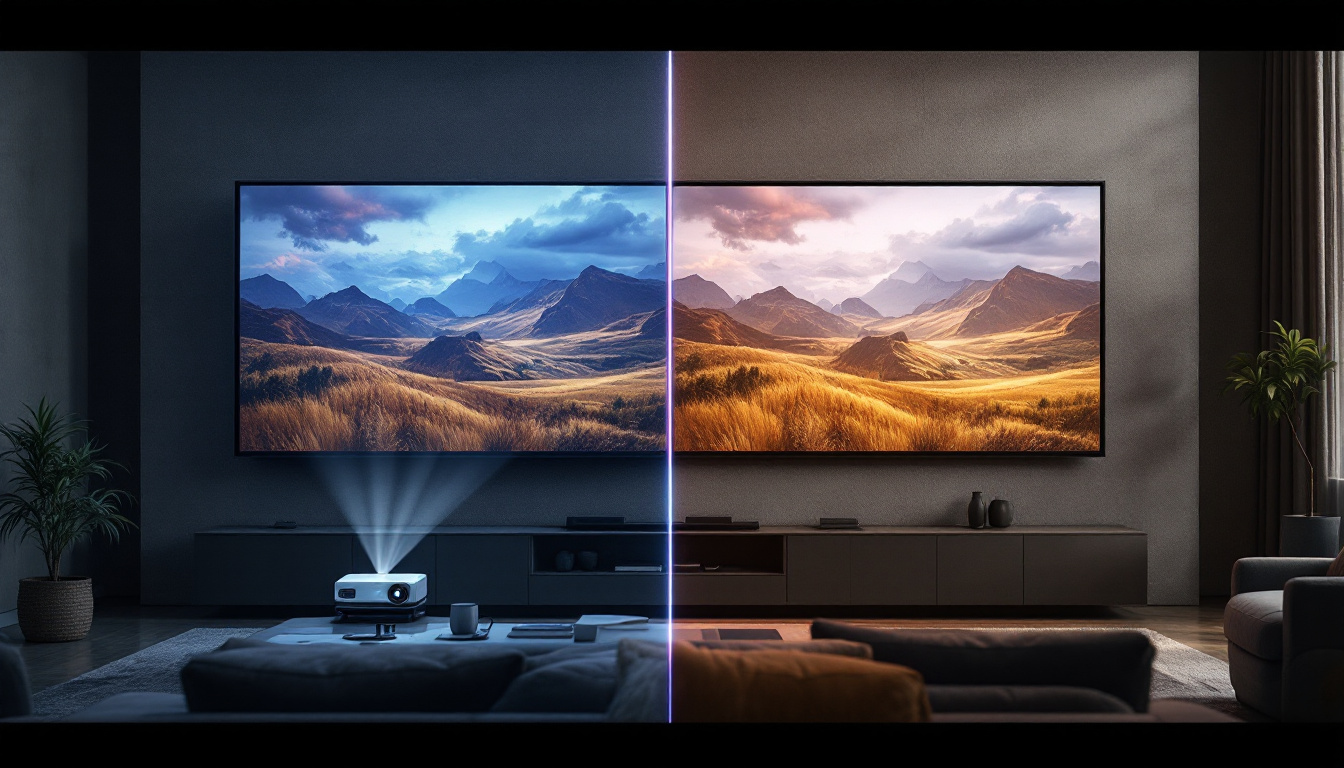Difference Between LCD And LED Television: LED Display Explained
In today’s rapidly evolving world of television technology, understanding the differences between LCD and LED televisions is crucial for making an informed purchase. While these terms are often used interchangeably, they represent distinct technologies that impact picture quality, energy efficiency, and overall viewing experience. This article explores the fundamental differences between LCD and LED televisions, explains how LED displays work, and provides insights to help consumers choose the right TV for their needs.
Understanding the Basics: What is LCD Television?
LCD stands for Liquid Crystal Display. This technology has been a staple in television manufacturing since the early 2000s, gradually replacing older cathode ray tube (CRT) models due to its slimmer profile and improved picture quality. An LCD television uses a liquid crystal solution sandwiched between two layers of polarized glass. When an electric current passes through the liquid crystals, they align in such a way that controls the passage of light, creating images on the screen.
However, LCD panels themselves do not emit light. Instead, they rely on a backlight to illuminate the screen. Traditionally, this backlight was provided by cold cathode fluorescent lamps (CCFLs), which are fluorescent tubes that shine light through the liquid crystals to produce visible images. This reliance on CCFL backlighting is what originally defined LCD televisions.
How Does the CCFL Backlight Affect Performance?
The CCFL backlight in traditional LCD TVs offers decent brightness and color reproduction, but it has limitations. These lamps consume more power and generate more heat compared to modern alternatives. Additionally, CCFL backlights are less capable of producing deep blacks because the light is always on behind the screen, leading to some light leakage and reduced contrast ratios. This results in images that can appear washed out, especially in dark scenes.
What is LED Television? Clarifying the Terminology
LED televisions are often marketed as a separate category, but fundamentally, they are a type of LCD television. The key difference lies in the backlighting technology. Instead of using CCFLs, LED TVs employ Light Emitting Diodes (LEDs) as their backlight source. This shift from fluorescent tubes to LEDs brings several advantages in terms of picture quality, energy efficiency, and design flexibility.
It is important to note that LED TVs are not a completely different display technology; rather, they are LCD TVs with LED backlighting. This distinction is often misunderstood by consumers, leading to confusion in the marketplace.
Types of LED Backlighting
LED backlighting comes in two primary configurations: Edge-lit and Full-array (also known as direct-lit).
- Edge-lit LED TVs: LEDs are placed along the edges of the screen, and light is diffused across the panel. This design allows for thinner and lighter TVs but can sometimes lead to uneven brightness or “clouding” effects.
- Full-array LED TVs: LEDs are distributed evenly behind the entire screen. This setup enables better control of brightness zones, improving contrast and reducing light bleed, especially when combined with local dimming technology.
Key Differences Between LCD and LED Televisions
Understanding the distinctions between LCD and LED TVs requires looking beyond the marketing labels and focusing on the underlying technology and performance characteristics.
Backlighting Technology
The most fundamental difference is the backlight source. LCD TVs use CCFL backlights, while LED TVs use LEDs. This difference affects several performance aspects:
- Brightness: LEDs can achieve higher brightness levels, making LED TVs better suited for viewing in well-lit rooms.
- Energy Efficiency: LEDs consume less power than CCFLs, which translates to lower electricity bills and a smaller environmental footprint.
- Thickness and Weight: LED backlighting allows for slimmer and lighter TV designs, enhancing aesthetics and ease of installation.
Picture Quality
LED TVs generally offer superior picture quality compared to traditional LCD TVs with CCFL backlights. The use of LEDs allows for better contrast ratios, deeper blacks, and more vibrant colors. Full-array LED TVs with local dimming can selectively dim or brighten specific screen areas, enhancing shadow detail and reducing halo effects around bright objects.
In contrast, LCD TVs with CCFL backlighting tend to have lower contrast and may suffer from light bleed, which can diminish the viewing experience, especially in dark scenes.
Color Accuracy and Range
LED backlighting can be tuned to produce a wider color gamut, meaning LED TVs often display more vivid and accurate colors compared to older LCD models. Advances in LED technology, such as quantum dot enhancements, push color reproduction even further, offering richer and more lifelike images.
Lifespan and Durability
LED backlights typically have a longer lifespan than CCFLs, with many LED TVs rated to last over 60,000 hours. CCFL backlights degrade faster and may require replacement after several years, which can be costly and inconvenient.
Cost Considerations
When LED TVs first emerged, they were significantly more expensive than LCD TVs with CCFL backlights. Today, however, LED TVs dominate the market and are available at a wide range of price points, often making them the more economical choice given their performance advantages.
How LED Displays Work: A Closer Look
To appreciate the benefits of LED televisions, it helps to understand how LED displays function.
The Role of LEDs in Backlighting
In an LED TV, the LEDs serve as the light source behind the LCD panel. These tiny diodes emit light when an electric current passes through them. The light passes through the liquid crystals, which modulate it to form the desired images.
Because LEDs can be individually controlled, especially in full-array configurations, the TV can adjust brightness levels in different screen zones dynamically. This capability, known as local dimming, enhances contrast and reduces unwanted light spill, resulting in a more immersive viewing experience.
Types of LEDs Used
Most LED TVs use white LEDs for backlighting, but some models employ RGB LEDs (red, green, and blue) or quantum dot technology to improve color accuracy and brightness. Quantum dot LEDs, for example, use semiconductor nanocrystals to emit precise colors, expanding the color range and enhancing picture quality.
Advantages of LED Backlighting
- Energy Efficiency: LEDs consume less power, reducing operational costs and environmental impact.
- Better Heat Management: LEDs generate less heat than CCFLs, contributing to longer component life and safer operation.
- Design Flexibility: The small size of LEDs allows manufacturers to produce ultra-thin TVs with sleek designs.
Common Misconceptions About LCD and LED TVs
Despite the widespread adoption of LED technology, several misconceptions persist among consumers.
“LED TVs Are Completely Different From LCD TVs”
As mentioned earlier, LED TVs are essentially LCD TVs with LED backlighting. The LCD panel remains the same; only the light source differs. This distinction is important because it clarifies that LED TVs are not an entirely new technology but an evolution of LCD technology.
“OLED and LED TVs Are the Same”
Organic Light Emitting Diode (OLED) technology is fundamentally different from LED-backlit LCD TVs. OLED pixels emit their own light and do not require a backlight, allowing for even thinner displays, perfect blacks, and superior contrast. While OLED TVs are often confused with LED TVs, they represent a separate category with distinct advantages and typically higher costs.
“More LEDs Always Mean Better Picture Quality”
While having more LEDs in a full-array backlight can improve local dimming and contrast, other factors like panel quality, processing algorithms, and color calibration also significantly influence picture quality. Therefore, the number of LEDs alone does not guarantee a superior viewing experience.
Choosing Between LCD and LED Television: What Should You Consider?
For consumers navigating the TV market, understanding the practical implications of LCD and LED technologies is essential.
Viewing Environment
If the TV will be used in a bright room with lots of ambient light, an LED TV with higher brightness capabilities is preferable. LED backlighting helps maintain image clarity and color vibrancy under such conditions.
Budget Constraints
While LED TVs have become more affordable, if budget is extremely tight, some entry-level LCD TVs with CCFL backlights might still be available. However, the price difference is narrowing, and LED TVs often provide better value for money.
Picture Quality Expectations
For cinephiles and gamers who demand high contrast, deep blacks, and vivid colors, LED TVs—especially those with full-array local dimming or quantum dot technology—offer a noticeable improvement over traditional LCD TVs.
Energy Efficiency and Environmental Impact
LED TVs consume less power and are more environmentally friendly. For those conscious about energy usage or looking to reduce their carbon footprint, LED technology is the better choice.
Future Trends in Television Display Technology
The television industry continues to innovate beyond LCD and LED technologies. OLED and MicroLED displays are gaining traction, offering even better contrast, color accuracy, and energy efficiency. Additionally, advancements in quantum dot technology and mini-LED backlighting are pushing the boundaries of what LED TVs can achieve.
Despite these emerging technologies, LED-backlit LCD TVs remain the most popular choice worldwide due to their balance of performance, price, and availability.
Conclusion
In summary, the primary difference between LCD and LED televisions lies in the backlighting technology. LCD TVs use CCFL backlights, while LED TVs employ LEDs, resulting in better brightness, energy efficiency, and picture quality. Understanding these distinctions helps consumers make informed decisions tailored to their viewing preferences, budget, and environment.
As technology advances, LED TVs continue to evolve, incorporating innovations like local dimming and quantum dots to enhance the viewing experience. While the terminology can be confusing, recognizing that LED TVs are a subset of LCD TVs clarifies the landscape and empowers buyers to choose the best television for their needs.
Explore Cutting-Edge LED Displays with LumenMatrix
As you consider upgrading to the latest in television and display technology, LumenMatrix stands at the forefront of innovation, ready to elevate your visual experience. Our extensive range of LED display solutions, from Indoor and Outdoor LED Walls to specialized options like Vehicle and Sports Displays, is designed to meet the diverse needs of our clients. Whether you’re looking to enhance brand visibility or captivate your audience with stunning visuals, LumenMatrix’s mission is to deliver digital signage and LED displays that communicate your message with unparalleled impact and clarity. Check out LumenMatrix LED Display Solutions and join the revolution in visual communication.































